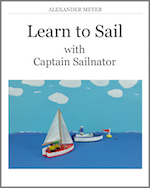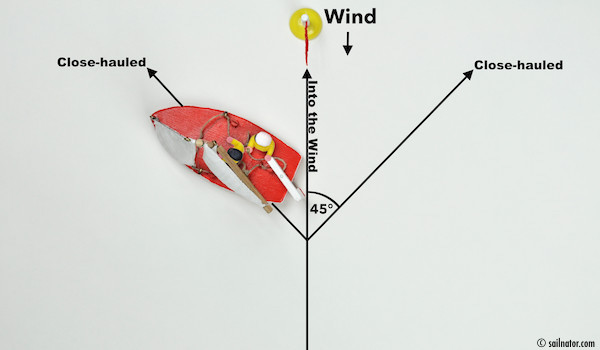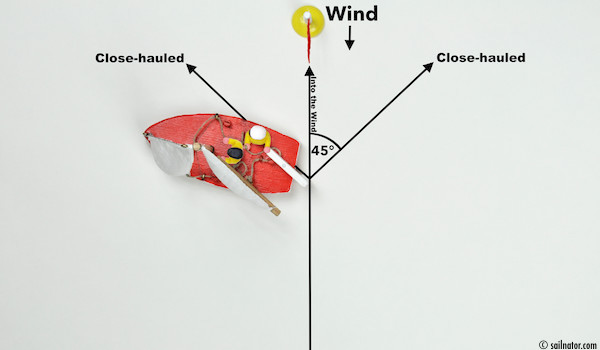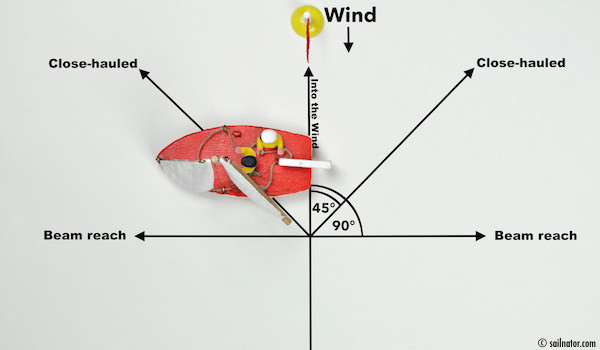In the last chapter we have learned that it is not possible to sail directly into the wind and the first point of sail is called close-hauled.
But what happens when we continue to turn away the bow of the wind, when we … ? Exactly, we bear away. To do that the helmsman has to operate the tiller of our little model-sailboat again. Does she have to pull it or push it … ? Right, she has to pull it. As soon as she leaves close-hauled, which is the border on to the zone where sailing is not possible, she sails close reach. That is the area between close-hauled and the next point of sail: beam reach.
 This online sailing course has also been published as ebook and paperback. For more information click here!
This online sailing course has also been published as ebook and paperback. For more information click here!
You can download the Ebook for example at:
iTunes UK & iTunes US | iBooks for iPad and Mac
Amazon.com & Amazon.co.uk | Kindle-Edition
Google Play | for Android
The paperback is available for example at:
Amazon.com | Amazon.co.uk
Now we bear away from close-hauled to beam reach and trim the sails in the proper angle to it. Do we now have to ease them or to haul them … ? Correct, we ease the sheets. It is not possible to haul the sails closer than they are when close-hauled. When we leave them hauled by bearing away they are not trimmed properly.

Figure 27: Command: “Ease sheets for beam reach!” and bear away from close-hauled at the same time.
But how wide do we open the sails when sailing beam reach? We ease the jib sheet until the jib starts to luff and pull it back till it fills again with wind. For the mainsail the rule of thumb is that the mainsheet block that is connected to the boom should be above the leeward edge of the hull. (Figure 28)

Figure 28: The mainsheet block that is connected to the boom stands above the leeward edge of the hull. Continue to bear away until the luff of the mainsail stops luffing.
Once the sails are trimmed in the described manner, we bear away slowly by … ? Right, pulling the tiller towards us. When doing so, the front edge of the mainsail, the luff, or the whole mainsail starts to luff. The moment we arrive at beam reach the mainsail does not flatter anymore. Now we can push the tiller into the middle. If the boat has a wind vane on the top of the mast it should now stand at an angle of 90 degrees to the boats keel line. That is an imaginary line from the middle of the bow to the middle of the stern. As soon as we have found beam reach we once again look over the bow for a prominent point on shore, for example a house or a tree, and head towards it to keep the course.

Figure 29: Command: “Sailing Beam reach!”
If we come from close-hauled and want to bear away to beam reach the command is: “Ease sheets to beam reach!” and “Sailing Beam reach!” When the course is found.
Watch again my stop motion video about the points of sail with Jenny and Tom →
That was the point of sail beam reach. When we want to go back to close-hauled we have to instruct the crew by using the command: “Sheet-in to close-hauled!” or “Head-up to close-hauled!” And when we hit the course we state that by saying: “Sailing close-hauled!” Are we therefore heading up or are we bearing away … ? Right, we are heading up. Do we push or pull the tiller to head up … ? Right, we push it away from us, provided we sit on the right side. Which is the right side for the helmsman to sit on … ? Right, opposite to the mainsail. Windward or leeward … ? Right, windward.
So now we have sailed half the wind rose already. In the next chapter we will see what happens when we keep on bearing away.
← Last chapter | Next chapter →
All chapters: Technical Terms | The theory behind sailing |Close-hauled | Beam reach | Broad reach | Sailing downwind | Tacking | Beating | Quick-turn | Sailing up head to wind | Man overboard | Jibing | Heaving-to | Leaving the dock | Berthing | Rules of the road 1 | Rules of the road 2 | Rules of the road 3 | Reefing | Capsizing